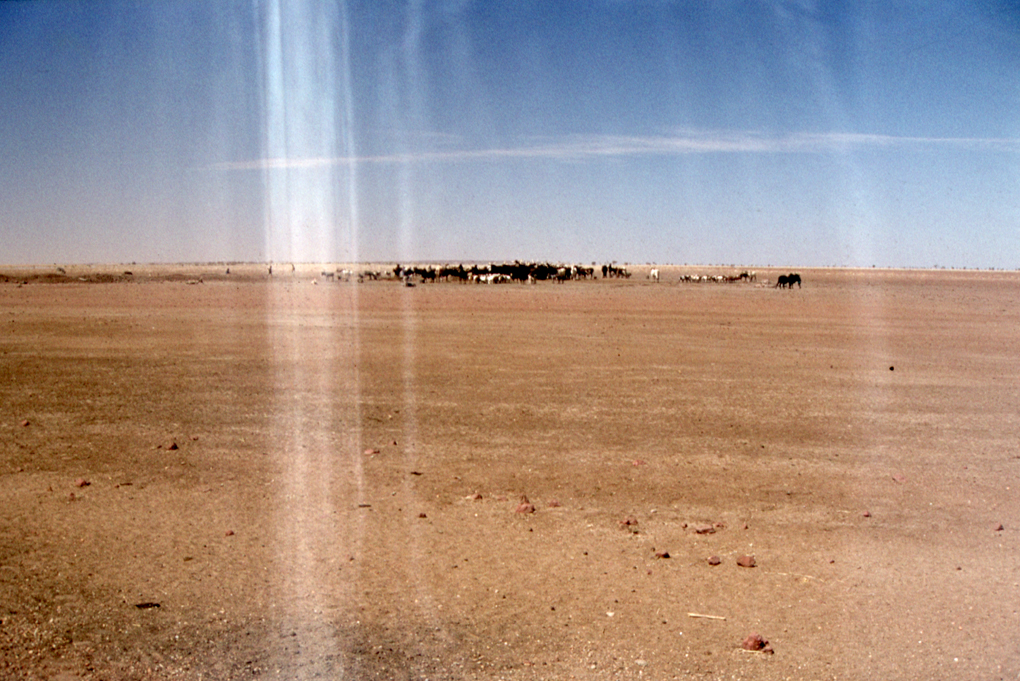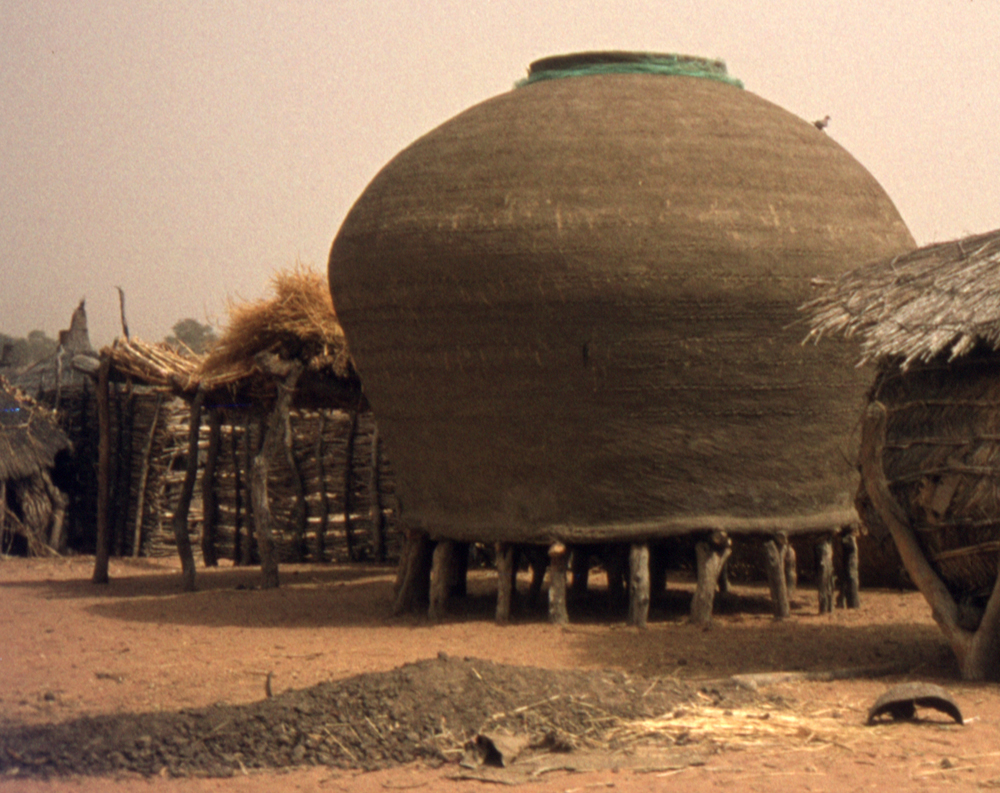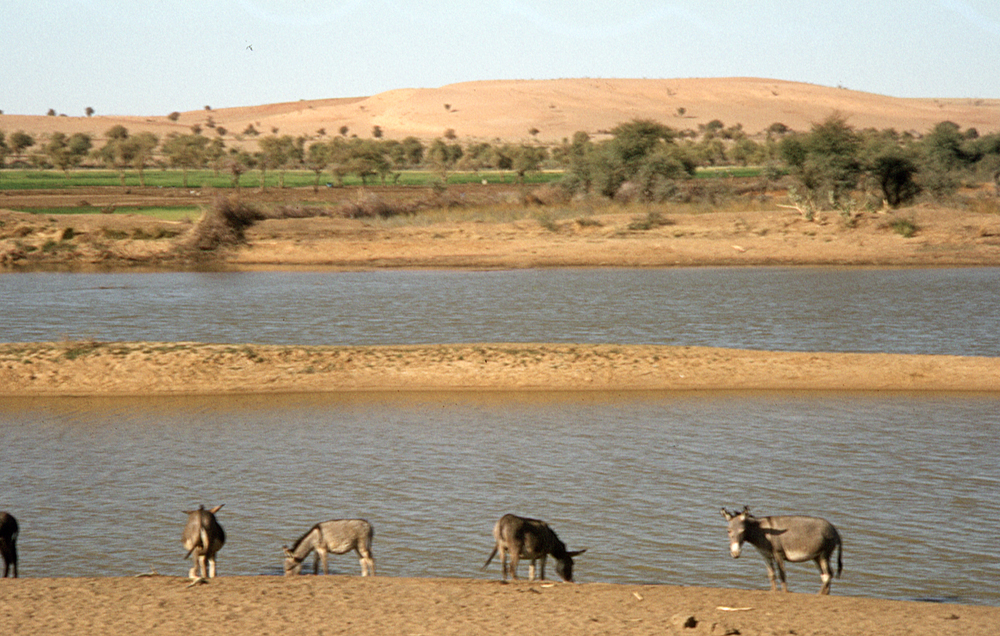
By Kae Lewis
On the outskirts of Arlit there is a modern uranium mine surrounded by gigantic piles of tailings. This is a French enterprise, and to serve the mine, they have built a bitumen road on which we were to travel in style to Agadez. However the streets of Arlit were unpaved, dusty and full of holes. The cool Saharan winter wind was not blowing in town, and it was now very hot and sultry for the first time since we had arrived in Africa.

We did not intend stopping in Arlit, staying only long enough to take on supplies of petrol, water and any fresh food we could buy. We were to find throughout our time in Africa that the cities and large towns held little for us. The streets were invariably crowded, dangerous or dirty, often all three, and there was seldom a place for us to camp. To safeguard our belongings, we were usually restricted to one of us remaining with the van. We did not enjoy exploring alone, and in any case, the real Africa for us was to be found in the countryside.


Of course we had to pay our mandatory visit to the Police Station in Arlit. The Police sent us to the Custom’s house to have the van thoroughly searched again, and later that day, we were finally issued with papers allowing us to travel to Agadez. If we had requested to travel into the Air Mountains in search of rock art, we would have been denied unless we arranged a local guide. In any case, our Niger visa expired on the 19th Feb, just over two weeks away. This did not give us time to arrange a local guide, wait for permission to proceed, take at least a few days for the trip and then get back down to the border. It may have been possible to extend the visa but we did not ask. Everything seemed such a bother to these police officials who operated at a glacial speed with everything they did.
We went a short distance out into the desert to a place where we had been told there was water. This turned out to be true, and we found clean water gushing from a pipe into an animal trough in what was possibly an animal sale-yard surrounded by high wooden fences. We were lucky there were no animals in residence at the time to compete with us for our water. That would have been a trial we would prefer to avoid because there was only one pipe and one animal trough. We had to sweeten the guard with some bonbons before he would allow us to take our 60 liters.

Later, at the market-place, we were able to buy tomatoes, sweet-corn and onions but there were no eggs or bread available and of course no meat. We had totally given up expecting to find that by now.
It was now a long time since we had been able to relax while driving but the road to Agadez was sealed, straight and beautifully made. It crossed semi-arid country with thorn bushes and little tufts of grass here and there. Soon we stopped to camp just off the road beside a solitary thorn tree.
Since water was at last in plentiful supply, a hot and dusty Evan immediately decided he was going to try out his shower. Previously we had always been too tired to set it up, and also we had not been able to waste water while crossing the Sahara. The shower hung on the outside of the van behind a makeshift shower curtain, with the water-pump from the sink used to pump a bucketful of warm water up through the shower nozzle. Evan had finally got this all set-up, stripped off and turned on the pump. Weeks of Saharan dust, sweat and oily grime from repairing the engine were swished away with the stream of warm water and lots of suds. It was a luxury we had failed to appreciate until we had been deprived of it for so long.
The bucketful of water was about half gone when a group of nosey Touareg mounted on their camels rode slowly past. They were almost falling off their high perches as they peered over to see what in the world was happening. It was just at that moment that a stiff Saharan wind blew the flimsy shower curtain perpendicularly straight upwards, and then the Touareg gentlemen did fall off their camels with laughter. I decided instantly that I preferred the privacy of the van and my usual sponge bath.

The next day, as we continued to cross the endless tundra, we passed many oases where the tribesmen had brought their thirsty goats, camels, donkeys and oxen to the trough. The largest oasis of them all is Agadez where there is a row of crude mud houses and shops cluttered along a dusty main street. We searched at once for the Police Station to apply for passport stamp and papers to proceed to the Nigerian border.



While we were there, we met Alison, an English girl and her Italian doctor friend Roberto. They were driving their Landrover southwards but they did not have a visa for Nigeria and would have to go to Niamey, the capital of Niger to obtain it. Since we had obtained our visa for Nigeria in London, we could go directly to Kano in Nigeria. But we all agreed to travel together the next day until our paths divided.
The petrol station was closed but there was a long queue of people waiting with plastic containers. They wanted kerosene for cooking and lighting, and we all continued to wait patiently in the hot sun. When it finally opened, we bought enough petrol to take us the 700 km to Kano as this would safeguard against unreliable supplies in the towns and villages along the way. There was water available in the market-place but we had to pay for it.
The rest of the afternoon was spent talking to other travelers under a shady tree in front of a café. Two tourists had reputedly been fined 15,000 francs (about US$60 and a veritable fortune to us) the previous day for camping in the open. And as it happened, there was a camping ground at Agadez. Although its reputation amongst the other tourists was not great, we felt it would be wise to use it that night. Alison had a guide book which described it as a veritable paradise complete with swimming pool and a French restaurant. It was also recommended in our guide book, Sahara Handbook and as they pointed out, it was an opportunity to meet other overlanders.
Because it was not sign-posted and situated way out in the desert, night had fallen before we eventually found it. A German had originally established the place and had maintained it with great efficiency. Since his death, his wife and family had obviously reverted to the African way. Consequently the swimming pool was black and fetid, there was no running water in the camp and the restaurant sold Cokes only but nevertheless the camping fees were extraordinarily high. So both our guide books proved out-of-date in the recommendation. However, as with all overlanders, we were independant, self-contained and undaunted by whatever we were confronted with. We spent an enjoyable evening in the company of other overlanders.
We left Agadez the next day with Roberto and Alison following in their Landrover. Along the way, each village was a tidy cluster of perfectly round little huts with thatched roofs and set off the road in a field of dry spindly grass. Standing on stone stilts amongst the huts and almost as high as them were rounded clay pots for storing grain. However the soil in the vicinity seemed so dry and lifeless that we began to wonder how they were able to grow the grain to fill them. Niger is one of the hottest countries in the world although while we were there, it was pleasantly cool, and perhaps one would have thought, the best growing season. However there was no rain and no rivers for irrigation.



We were stopped every 100 km or less at police checkpoints for them to see that our travel papers and passports with border stamp were in order. It would have been trouble for us if we had failed to obtain the stamps from all the other police posts along our route. Our travel papers from Agadez gave us seven days to reach the Nigerian border. This paper was meticulously checked over and over again with all the details being recorded laboriously in a ledger.



Towards evening, we decided to visit the market town of Tohoua and with Roberto in his brand new Landrover leading the way, drove slowly down the crowded main street. Suddenly his back wheel went down into a large hole which seconds before had not been there. We all got out and found that he had driven over a man-hole cover hidden in the dust, and with the weight of the vehicle on one side of the cover, it had turned and tipped poor Roberto into the main sewer. He was quite flustered and angry when he saw what had happened. However with the powerful 4-wheel drive and not forgetting all the advice of the friendly cluster of villagers we had attracted, Roberto was able to drive out. The market was closed, and we went out of town to camp for the night in a field covered in dried grasses that relentlessly speared us with very long toothy thorns.

Using the extract from the Michelin map shown in the previous chapter (Chapter 7: From the Niger Border to Arlit), it can be seen that we followed a circular route from Assamakka to Tahoua and were now immediately south of Assamakka. We had circled around the low-lying area called the Vallée de Azaouagh which is subject to flooding and where there is no through road. This is where we would have ended up if we had not turned back in the sand storm to find Assamakka when we did. In any case, our permit only allowed us to travel via Arlit and Agadez on the official piste. Independant travel in Niger is permitted but very carefully controlled every inch of the way.
The next morning, we parted company with Alison and Roberto at the crossroads. Although we made tentative plans to meet up later, we were not to see them again. We heard several days later on the tourist grapevine that visas for Nigeria were not available in Niamey, and that they would have to go to Upper Volta over an almost impassable road to get them.
We were pleased that we had obtained our Nigerian visas in London because we were always conscious throughout this time of the need to keep going towards central Africa before the rains came. Although we did not break any records or drive for long hours at a time, we refrained from taking any side trips that could take days or weeks at a time. We were lucky because it was the extra effort at this stage which ultimately led to the success of our expedition.
The road was now filled with potholes, and once more, we were only crawling along. A strong wind tore across the land and was creating havoc. The overgrazed pastures had exposed the sand which was being blown across to cover what little fertile soil remained. The demands of an ever-increasing population for firewood and grazing was quite obviously encouraging the Sahara’s relentless spread southwards.

We reached Dan Issa, the Nigerian border town that night and camped beside the road just before it. Our very own garden boy (an elderly gentleman in fact) came uninvited and swept clear an area around our door so that there would not be any dried sticks for us to tread on. He received some bread for his trouble (and enterprise) although he quickly indicated that he would much prefer a shirt. We had by now made the transition from a predominantly Arab population to an area were the people were all Negroid. However the Muslim religion was still predominant.

© Copyright Kae & Evan Lewis 2019. All rights reserved.
